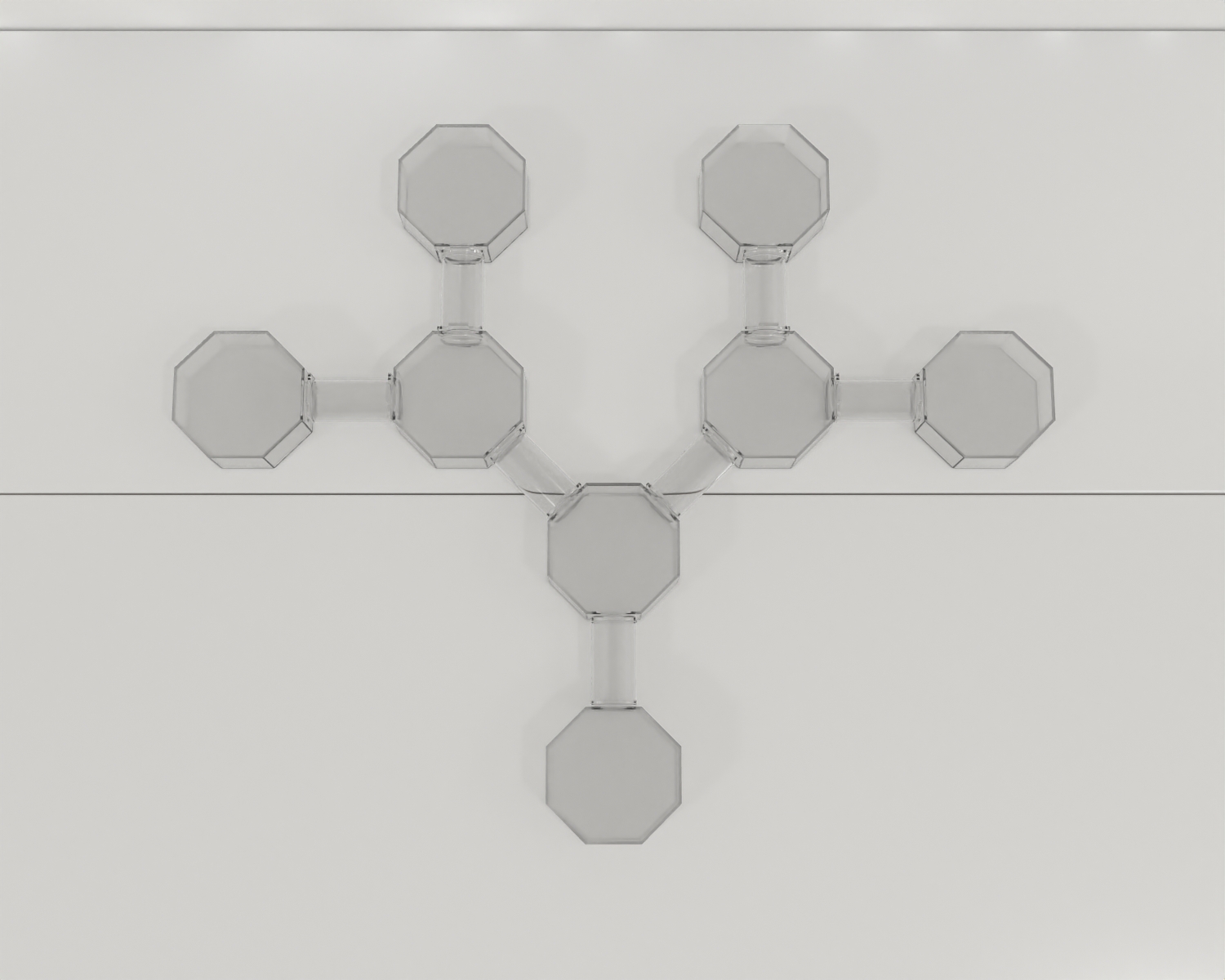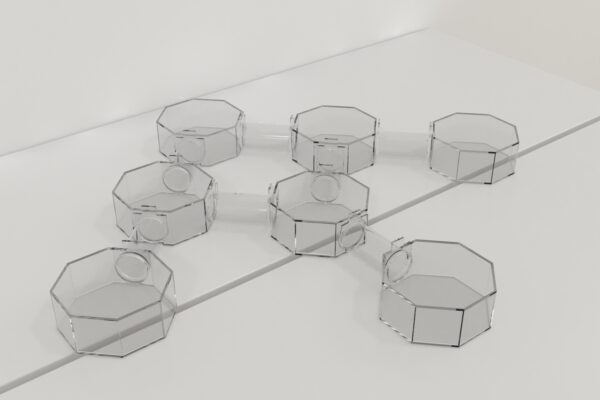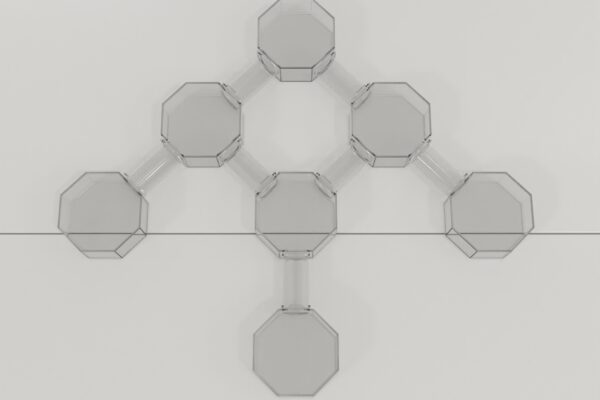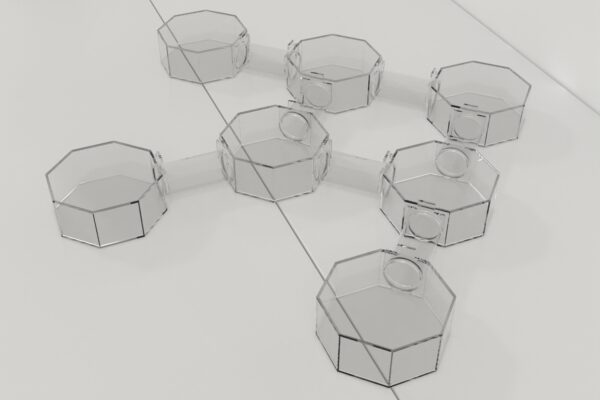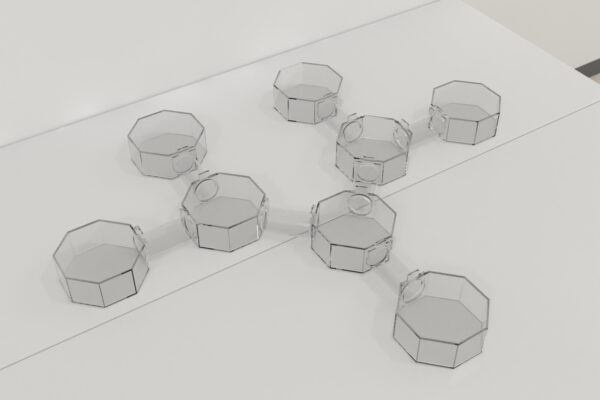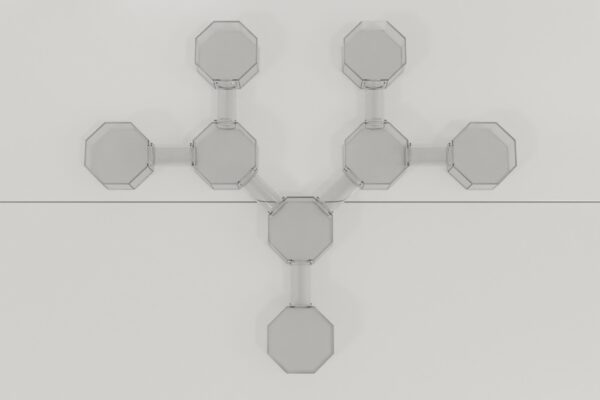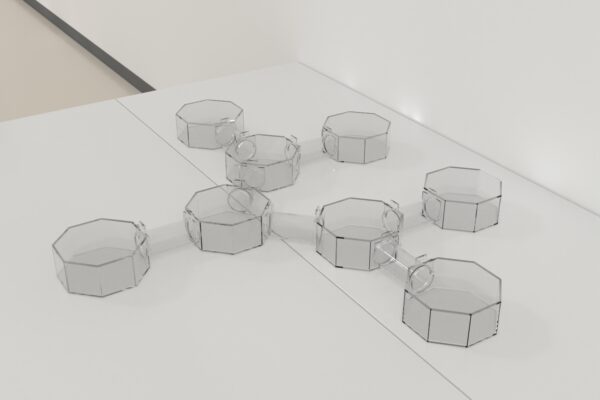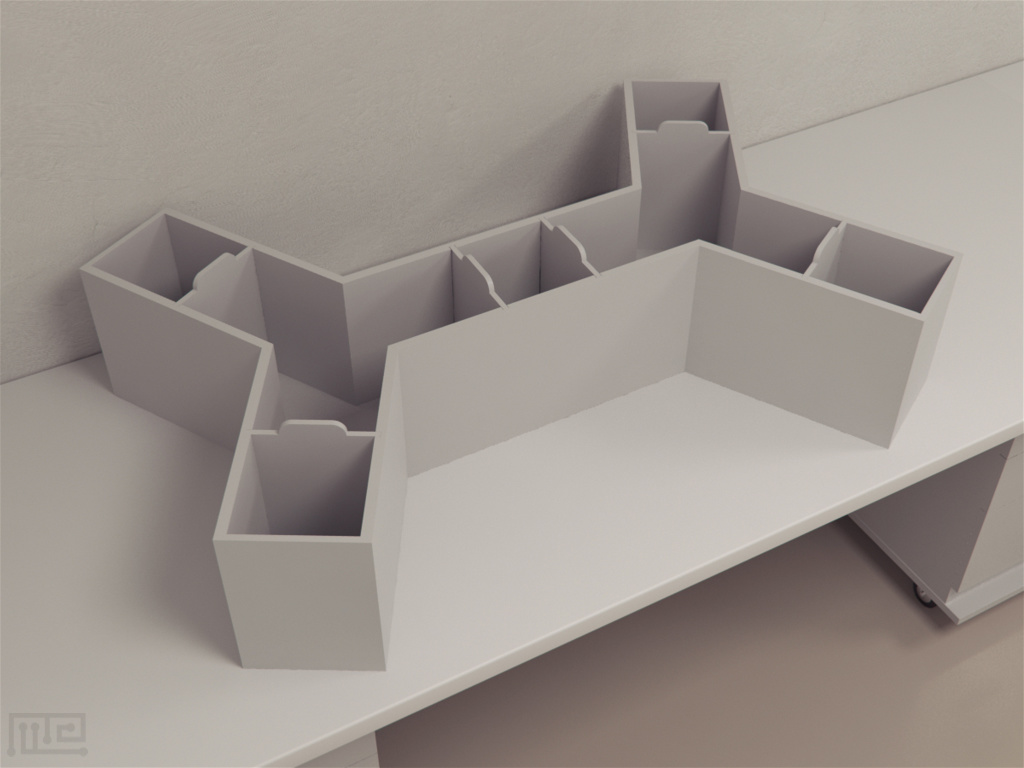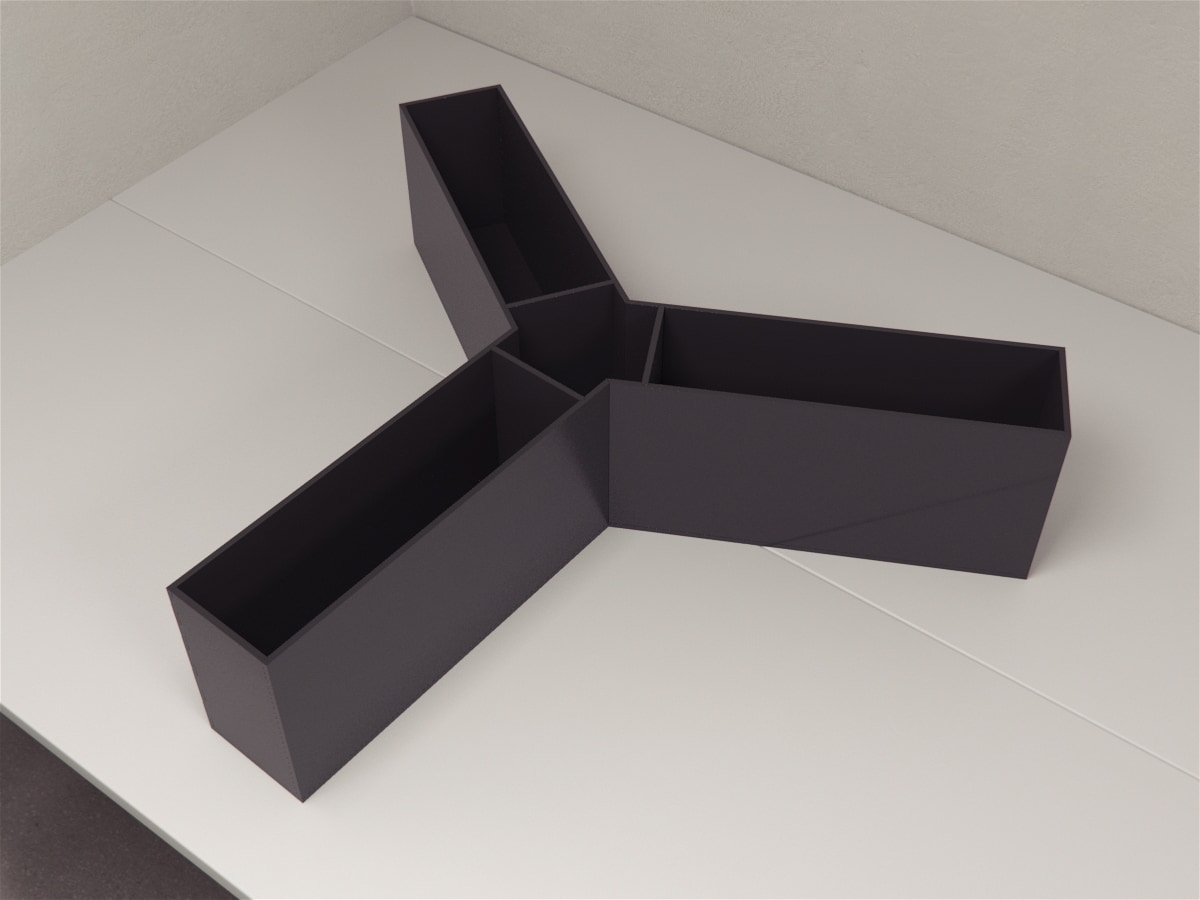Developed by Ainge, Tamosiunaite, Woergoetter, and Dudchenko (2007), the Concatenated Y-Maze is a branching Y-Maze used to observe choice behaviors and spatial learning and memory in rodents. It contains a start box, three choice points, four goal boxes, and connecting alleyways, which are arranged in a double Y-Maze configuration.
Price and Specifications
Mouse
$ 1190
Per Month- acrylic (customizable colors)
- Octagonal start box area, three choice points, four-goal boxes: 15 cm L of each wall and 30 cm high walls.
- Double Y-Maze configuration. with connecting alleyways: 15 cm in length, 5 cm in width, and 6cm high walls.
- A round ceramic food bowl for each goal box: 3cm depth
- Easy clean with 70% Ethanol
- No Odors
- Matte Finish to remove shine
Rat
$ 1390
Per Month- acrylic (customizable colors)
- Octagonal start box area, three choice points, four-goal boxes: 25 cm L of each wall and 40 cm high walls.
- Double Y-Maze configuration. with connecting alleyways: 25 cm in length, 8 cm in width, and 10 cm high walls.
- A round ceramic food bowl for each goal box: 5cm depth
- Easy clean with 70% Ethanol
- No Odors
- Matte Finish to remove shine
Introduction
Studies on understanding spatial navigation and memory usually explore hippocampal place cell activity. This is because the hippocampus contains a cognitive map of the individual’s surroundings and uses the spatial receptive fields of place cells to encode locations. Although place cells encode the current location of an animal in its environment, they can also be used to investigate goal-directed behavior (Grieves, Wood, & Dudchenko, 2016). The Concatenated Y-Maze can easily analyze goal-directed behavior in rodents since the subject reaches its goal destination (the goal box) after making a decision at three choice points of the maze. It challenges the subject’s spatial navigation abilities further than the standard Y-Maze, which only has a single decision point. During behavioral testing, two of the goal boxes are baited with a food reward, such that both of the final decision points of the maze leads to a baited or unbaited goal box. Goal-directed behavior can be further analyzed by baiting the reward bowls with a large amount of food that cannot be consumed within a single trial. This can be used to observe whether the animal returns to the previously rewarded location in which they believe a reward will still be present.
The Concatenated Y-Maze can also be used to analyze spatial navigation and hippocampal place cell activity in other tasks, such as a conditional discrimination task (Ainge, Tamosiunaite, Wörgötter, & Dudchenko, 2011). During this task, spatial navigation can be tested in the presence or absence of information about the location of the reward provided by a light cue, odor cue, or any other stimuli. Therefore, the maze can be easily adapted for several experiment needs.
Apparatus and Equipment
The maze is constructed out of acrylic and is opaque black. It comprises a start box area, three choice points, four-goal boxes, and connecting alleyways, which are arranged in a double Y-Maze configuration. The start box, goal boxes, and choice points are octagonal in shape and connected by Alleyways between opposing edges and walls. A round ceramic food bowl is present in each goal box.
Each goal box can be equipped with different objects and perspex figures (attached to the walls opposite the object) to help the animals distinguish them from each other during testing.
The maze can be mounted on a stool, which raises it from the floor to limit vibrational stimuli. Moreover, extra maze cues can be eliminated by placing the maze in a square-curtained enclosure.
Rodent location can be tracked using a video tracking software package such as Noldus EthoVision, ANY-Maze, or BehaviorCloud.
Training Protocol
The following is a sample protocol used to examine spatial navigation and choice behaviors in rodents:
Habituation
Place the subject in the maze without any food or food bowls present and allow it to explore the maze for 10 minutes. Conduct two sessions for habituation.
Concatenated Y-Maze Task
Add food bowls to all four goal boxes. Bait two food bowls and leave the other two un-baited. Fill the baited bowls to the top such that the subject cannot consume it all in an individual trial. This is done to increase the likelihood that the subject would return to the rewarded goal boxes. Rodents are predicted to return to a spot more frequently if they believe there is still food there rather than if they have already eaten all the rewards. Leave cereal dust in the unbaited bowls to control odor cues.
Place a barrier between the start box and connecting alleyway to block the start box from the rest of the maze. Place the subject in the start box and allow it to remain in it for a few seconds. Remove the barrier and allow the subject to explore the maze and choose a goal box. If the subject chooses a baited goal box, allow it to eat the food for 5 seconds. If the subject chooses an unbaited goal box, place a barrier behind the rat and keep it in the goal box for 5 seconds. Pick up the subject from the goal box and place it back into the start box with the barrier present. Wipe the rest of the maze with a weak detergent solution and begin the next trial, such that the inter-trial interval is 10 seconds.
Conduct trials in blocks of 10. Bait the same two boxes for 10 trials and then shift the food reward to another combination of boxes such that all combinations of boxes are presented. To guarantee the subject visits each box, pseudo-randomize the order of the baited boxes within 1 day. Conduct trials until the subject reaches the learning criterion of 75% correct choices in 20 trials within 1 day for 4 days.
Data Analysis
The following parameters can be observed using the concatenated Y-Maze:
- Number of correct choices (entries to the baited boxes)
- Number of incorrect choices (entries into the unbaited boxes)
- Number of times the subject returned the previously visited goal box on a consecutive trial
- Trial duration
Literature Review
Investigation on whether Hippocampal CA1 place cells encode their destination on a maze task
Ainge, Tamosiunaite, Woergoetter, and Dudchenko (2007) investigated whether Hippocampal CA1 place cells encode their destination on the Concatenated Y-Maze. Male Lister hooded rats were used in the study. During testing, two of the four goal boxes of the mazes were baited. The subjects were allowed to explore the maze and make a choice to access one of the four possible goal locations. The location of the rewards was kept the same for each trial block and then switched to other locations so that the subjects were presented with all possible rewarded locations. The results from the task revealed that the rats took an average of 13 days to reach a criterion level of performance (i.e., 75% correct for 4 consecutive days). They made correct choices 77.3% of the time during the test trials. Analysis of place field firing indicated that the start box and beginning stem of the maze had more place fields than other parts of the maze. On journeys to the different goal boxes, forty-six percent of these place fields had different firing rates. Before the second decision point, another group of cells had place fields, and of these, forty-four percent differentiated between routes to different specific goal boxes.
A second experiment was also performed in which the performance of rats with hippocampal brain lesions was tested on the maze. The results indicated that hippocampal damage caused the subjects to make significantly more errors than control subjects when the reward locations were reversed.
Overall results from the two experiments show that the hippocampus encodes the rat’s current location and intended destination at the beginning of the maze and that this encoding is essential for the rat to be able to respond quickly to changes in the reinforcement contingencies.
Strengths and Limitations
Strengths
The Concatenated Y-Maze is adapted from the standard Y-Maze and contains a double Y-Maze configuration. Therefore, the choice behaviors of rodents are examined at three choice points. The maze can be used to study spatial navigation, memory, and goal-directed behavior. It has four goal boxes, in which two are baited for each trial block. The configuration of the reward location can be changed between the goal boxes for other trial blocks to present the subject with multiple reward locations. Different objects can be attached to the goal boxes to allow the subject to easily discriminate one goal box from the other. However, other discriminatory stimuli such as light cues or tactile cues can also be utilized. The shape of the goal boxes and start box allows barriers to be easily inserted at their entry to enclose the subject within them for habituation or inter-trial intervals.
Limitations
Extra-maze cues can potentially affect task performance; therefore, the maze should be placed within a curtained enclosure. Moreover, odor cues emanating from the rewarded bowls can affect choice behaviors; therefore, the unbaited bowls should be sprinkled with some food dust to control odor cues. The exploratory behavior of the subject is important for task performance.
Summary
The Concatenated Y-Maze is a branching Y-Maze, used to observe choice behaviors and spatial learning and memory in rodents.
- It contains a start box, three choice points, four goal boxes, and connecting alleyways, which are arranged in a double Y-Maze configuration.
- The start box, goal boxes, and choice points are octagonal in shape.
- The Concatenated Y-Maze has three decision points, which challenges the subject’s spatial navigation abilities and goal-directed behaviors further than the standard Y-Maze, which only has a single decision point.
- The subject can be presented with several different reward locations by switching the reward configuration between the four goal boxes.
- Different objects can be attached to the goal boxes to allow the subject to easily discriminate one goal box from the other. However, other discriminatory stimuli such as light cues or tactile cues can also be utilized.
References
Ainge, J. A., Tamosiunaite, M., Woergoetter, F., & Dudchenko, P. A. (2007). Hippocampal CA1 place cells encode intended destination on a maze with multiple choice points. The Journal of neuroscience : the official journal of the Society for Neuroscience, 27(36), 9769–9779. https://doi.org/10.1523/JNEUROSCI.2011-07.2007
Grieves, R. M., Wood, E. R., & Dudchenko, P. A. (2016). Place cells on a maze encode routes rather than destinations. eLife, 5, e15986. https://doi.org/10.7554/eLife.15986
Ainge, J. A., Tamosiunaite, M., Wörgötter, F., & Dudchenko, P. A. (2012). Hippocampal place cells encode intended destination, and not a discriminative stimulus, in a conditional T-maze task. Hippocampus, 22(3), 534–543. https://doi.org/10.1002/hipo.20919
Are you an academic scientist and creator?
Learn how your lab can tech transfer this and similar devices from your lab to industry.

